

For Teachers - Learning Disabilities Association of America. Since almost five percent of all students in our nation’s public schools are classified as having specific learning disabilities (SLD), every teacher can expect to find students with learning disabilities in the classroom.
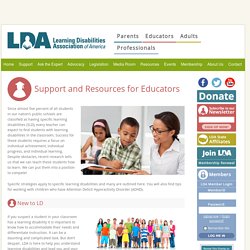
Success for these students requires a focus on individual achievement, individual progress, and individual learning. Despite obstacles, recent research tells us that we can teach these students how to learn. We can put them into a position to compete! Specific strategies apply to specific learning disabilities and many are outlined here. You will also find tips for working with children who have Attention Deficit Hyperactivity Disorder (ADHD). New to LD If you suspect a student in your classroom has a learning disability it is important to know how to accommodate their needs and differentiate instruction.
Learn more about LD Specific Learning Disabilities Dyscalculia Dyslexia Related Disorders Memory LD/ADHD Basics Assessment & Evaluation Early Intervention Teaching Reading. Teaching Students with Disabilities: Applying and Learning Scientific Habits of Mind. AIBS Eye on Education Susan Musante Jay Hatch, associate professor of biological sciences at the University of Minnesota (UMN) and associate curator of fishes at the Bell Museum of Natural History in Minneapolis, has been a scientist for over 25 years.
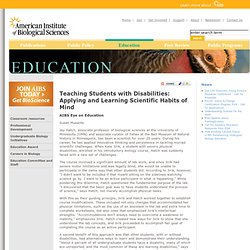
During his career, he has applied innovative thinking and persistence in tackling myriad scientific challenges. When Kate Jirik, a student with severe physical disabilities, enrolled in his introductory biology course, Hatch was suddenly faced with a new set of challenges. The course involved a significant amount of lab work, and since Jirik had severe motor limitations and was legally blind, she would be unable to participate in the same way that other students did. With this as their guiding principle, Jirik and Hatch worked together to establish course modifications. A second benefit of this approach was that other students, with or without disabilities, had alternative ways to learn and demonstrate their understanding.
Teacher Resources for ADHD Children and Learning Disabled Students. Understanding Kids Who Are Different: Activities for Teachin... April is Special-Education Month.
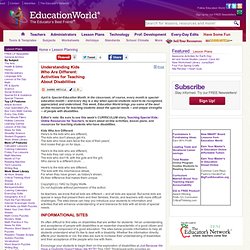
In the classroom, of course, every month is special-education month -- and every day is a day when special students need to be recognized, appreciated, and understood. This week, Education World brings you some of the best on-line resources for teaching students about the special needs -- and unique strengths -- of people with disabilities. Editor's note: Be sure to see this week's CURRICULUM story, Teaching Special Kids: Online Resources for Teachers, to learn about on-line activities, lesson plans, and resources for teaching students who have disabilities.
Kids Who Are Different Here's to the kids who are different, The kids who don't always get A's, The kids who have ears twice the size of their peers', And noses that go on for days . . . Here's to the kids who are different, The kids they call crazy or dumb, The kids who don't fit, with the guts and the grit, Who dance to a different drum . . .
Copyright (c) 1982 by Digby Wolfe. Disability_Awareness.pdf. Successful Strategies for Teaching Students with Learning Disabilities - Learning Disabilities Association of America. Research continues to confirm that we can teach students with learning disabilities to “learn how to learn.”
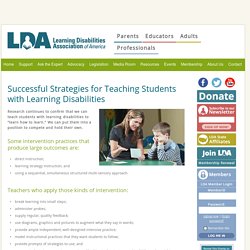
We can put them into a position to compete and hold their own. Some intervention practices that produce large outcomes are: direct instruction;learning strategy instruction; andusing a sequential, simultaneous structured multi-sensory approach. Teachers who apply those kinds of intervention: break learning into small steps;administer probes;supply regular, quality feedback;use diagrams, graphics and pictures to augment what they say in words;provide ample independent, well-designed intensive practice;model instructional practices that they want students to follow;provide prompts of strategies to use; andengage students in process type questions like “How is the strategy working? Scaffolding is also something that seems to make a real difference. Guidelines for teaching students with disabilities. Many teaching strategies that assist students with disabilities are also known to benefit students without disabilities.
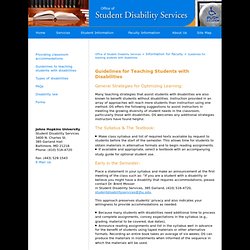
Instruction provided in an array of approaches will reach more students than instruction using one method. DS offers the following suggestions to assist instructors in meeting the growing diversity of student needs in the classroom, particularly those with disabilities. DS welcomes any additional strategies instructors have found helpful. Make class syllabus and list of required texts available by request to students before the start of the semester. This allows time for students to obtain materials in alternative formats and to begin reading assignments.If available and appropriate, select a textbook with an accompanying study guide for optional student use. This approach preserves students’ privacy and also indicates your willingness to provide accommodations as needed.
A student needs official authorization before receiving accommodations. Tips%20for%20Teachers. Teaching Students with Disabilities. Autism Speaks.